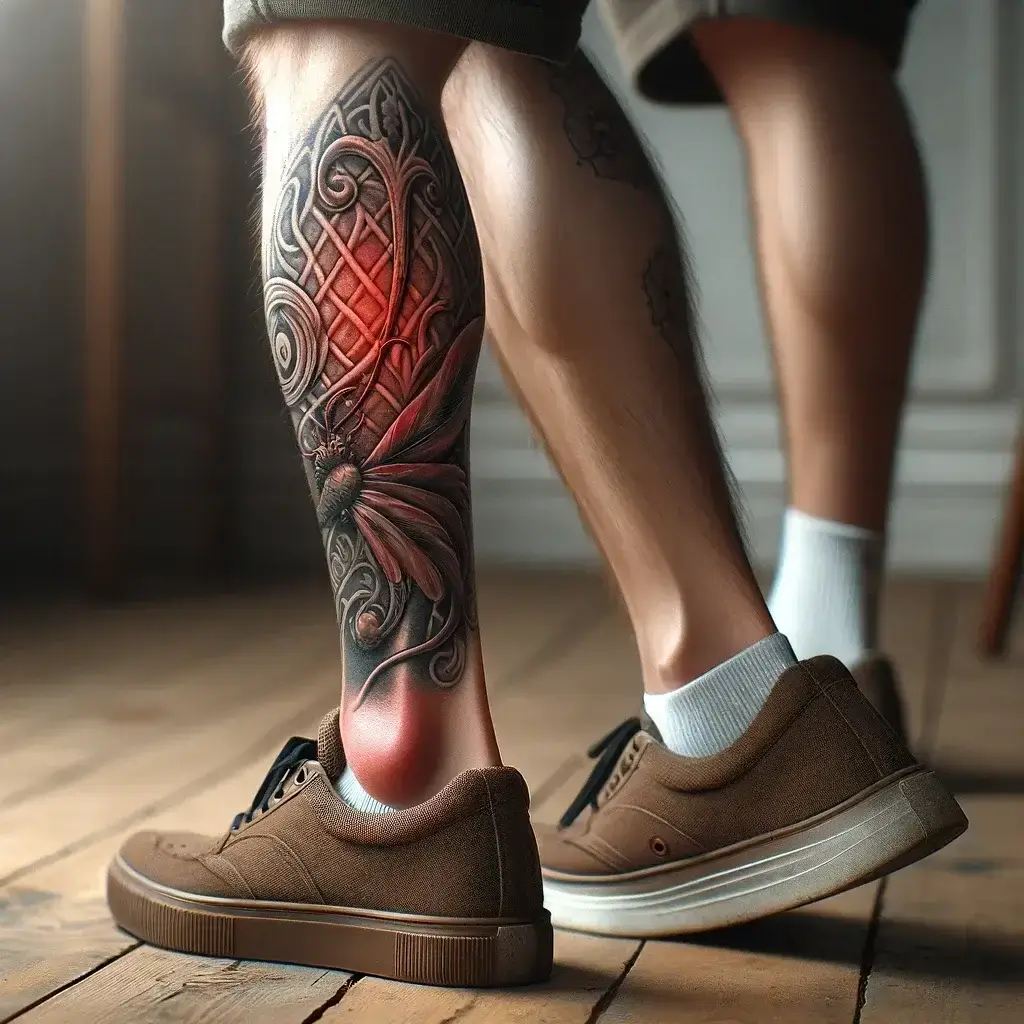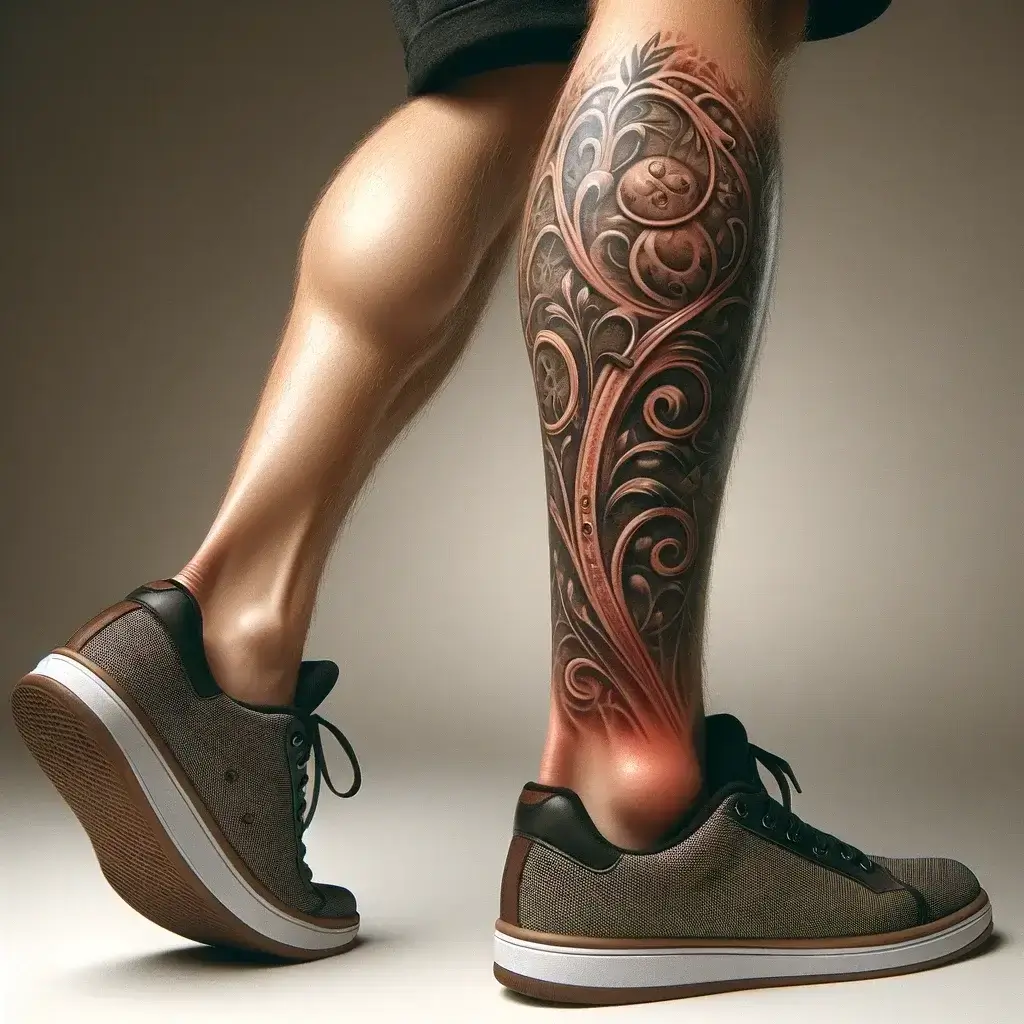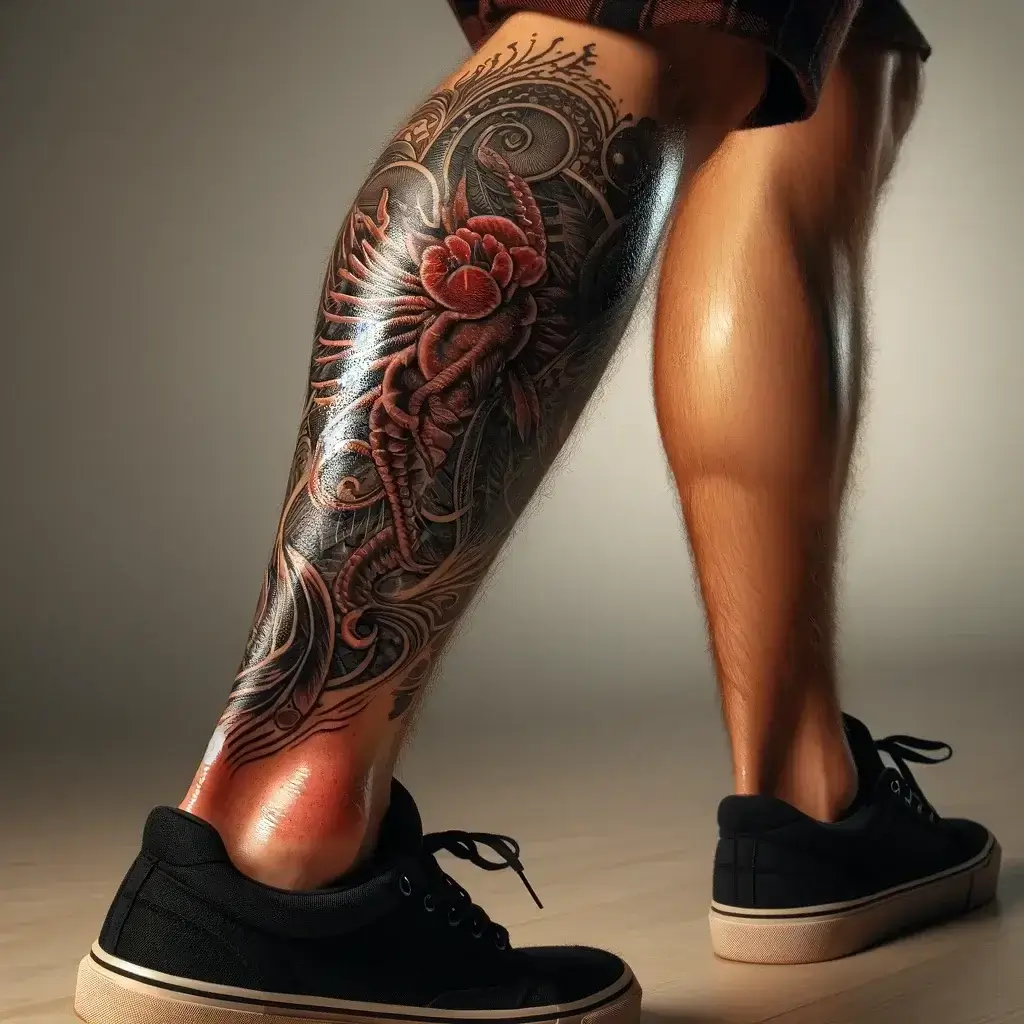When you get a calf tattoo, it’s common to find that your calf tattoo hurts to walk afterwards. This pain is due to the sensitive nature of the calf area, which is rich in nerves.
From personal experience, I can say that the discomfort is quite noticeable, especially when trying to walk. The reasons behind this include the skin’s reaction to the tattoo needle and the healing process.
To reduce this discomfort, gentle movements and avoiding strenuous activities are key. Also, adhering to the aftercare instructions provided by your tattoo artist is crucial.
These typically involve keeping the area clean and moisturized, which helps in managing the painful aftermath. In the FAQs about calf tattoos, many ask about managing this pain, and the answer often lies in patience and proper care.
Also Read: How Long To Leave Tegaderm On Tattoos
Are Calf Tattoos Painful?
Getting a calf tattoo can be a painful experience for many. The degree of pain experienced during the tattooing procedure can vary significantly depending on several factors.
Compared to other body parts like the ribs or skulls, the calf has a number of aspects affecting its pain level. One major factor is the balance between muscle, fat, and nerve endings in the calf area.
When the tattoo needle is poked into the skin, areas with less cushion — like those with less fat and more nerve endings — tend to be more painful.
In contrast, areas with more fat may offer a moderate amount of cushioning, thereby reducing the pain slightly. The density of muscle and nerve endings in the calf can make the tattooing process quite intense for some.
However, using a numbing agent can help manage the pain, making the experience more bearable.
Also Read: Can You Get A Tattoo On Accutane

5 Reasons Why Calf Tattoo Hurts To Walk
A calf tattoo can cause a moderate level of pain, making walking an irritating experience. The hurting in the calf area has various reasons, which are listed in the following sections.
1. Inflammation And Swelling
Inflammation and swelling are common after getting a new tattoo, especially in the calf area. This natural part of the healing process can increase pain, making it challenging to walk.
Typically, the swelling subsides within a week, but if it persists, consulting your tattoo artist or a doctor is advisable.
2. Muscle Movement
The muscle movement of the calf muscle plays a significant role in why a calf tattoo can hurt to walk. When we extract or subtract our leg, the skin, especially tattooed skin that hasn’t fully healed, tends to stretch, causing discomfort.
3. Friction
Friction, especially from fabric friction, can cause significant irritation to a new calf tattoo. Wearing tight clothing or a dress that applies pressure on the tattooed area exacerbates the discomfort, making it painful to walk.
4. Tattoo Size And Detail
The tattoo size and detail significantly impact the discomfort experienced. A big-sized, intricate design on the calf can increase discomfort and pain when you walk.
This is because a larger tattoo is essentially a bigger wound, which becomes more sensitive to movements, stretch, and friction.
5. Infection
An infection can occur if proper care is not taken with a healing tattoo. If the tattoo becomes infected, this can significantly increase pain and discomfort, making it difficult to walk.
Also Read: How Soon After Laparoscopic Surgery Can I Get A Tattoo
Can You Walk After A Leg Tattoo?
Walking is generally fine after getting a fresh new tattoo, but it’s important to remember that your tattoo is an open wound.
It’s prone to getting infected, so you should consider certain precautions and avoid activities or environments that might exacerbate the risk.
1. Avoid Exercises Until The Tattoo Is Healed
It’s crucial to wait at least 2-3 days before resuming exercises like running or jogging with a fresh tattoo.
Sweating and rubbing from cloth during workouts that target the tattooed area should be avoided until it’s fully healed, as these can negatively affect the healing process.
2. Exposing Your Tattoo To Sunlight
Keeping a tattoo exposed to the sun for long periods increases the risk of it becoming bleached or faded due to UV rays being absorbed by the pigment.
To avoid these effects, it’s best to either avoid direct sun exposure or cover up with baggy, long sleeve clothing that won’t rub against the tattoo.
3. Don’t Get The Tattoo Wet Or Soaked With Water
It’s necessary to keep a fresh tattoo, especially one only a couple weeks old, from getting wet or soaked with water.
For this purpose, it’s crucial to avoid activities like swimming or others that involve soaking the tattoo until it’s fully healed, typically after 3-4 weeks.
Also Read: Is Dermasil Good For Tattoos
8 Ways To Reduce Calf Tattoo Pain To Walk
Reduce your calf tattoo pain to make walking more comfortable by doing these things:
1. Taking Proper Aftercare
Effective aftercare reduces swelling, eases pain, and makes walking more comfortable.
2. Wearing Loose-Fitted Pants Or Dresses
Switch from tight pants or dress to loose-fitted pants or dresses to decrease fabric friction and ease pain on your calf tattoo.
3. Limit Your Physical Activity
Reducing physical activity like outdoor sports, jogging, or strenuous exercise helps to prevent added stress and strain on a fresh tattoo. This is crucial until the tattoo heals, aiding in less pain while you walk.
4. Choosing A Smaller And Simple Calf Tattoo Design
Opting for a smaller and simple calf tattoo design can result in a smaller skin wound that heals faster, reducing discomfort and pain while you walk.
5. Moisturize
Regularly applying moisturizer to a dry tattoo can keep the tattooed skin soft, reduce tightness from stretch, and ease pain while you walk with a calf tattoo.
6. Protect With Bandage
Using tattoo-specific bandages like Saniderm can shield against friction and external elements; properly bandaging helps reduce pain when you walk.
7. Elevate Your Leg
Elevating your leg can help decrease swelling, thereby reducing pain and making it easier to walk after getting a calf tattoo.
8. Pain Relief Medicine
Using over-the-counter pain relief medicines like acetaminophen or ibuprofen can alleviate pain associated with a new calf tattoo.
Also Read: Unlock The Secret: Why Is My Tattoo Shiny
When To Seek Medical Help?
Knowing when to seek medical help is crucial if pain from a calf tattoo gets worse or if there are signs of infection.
It’s important to consult a doctor if prescribed medicine doesn’t alleviate increased pain or discomfort, or if you notice your tattoo fading or distortion. These could be indications of delayed healing or permanent scarring.
If within a week of getting the tattoo, walking becomes increasingly painful, or if swelling, redness, and warmth persist or worsen, especially if it’s swollen beyond 2 weeks, it’s time to seek professional advice.
Additional symptoms like a rash or fever are clear signs your calf may be infected and require immediate attention.
Calf Tattoo Healing Time
The calf tattoo healing time varies, primarily due to the sensitive nature and placement on a part of the body that moves a lot.
Normal activities like walking can stretch the skin in the calf tattooed area, potentially delaying the healing process.
It’s critical to limit intense physical activity, especially those like running, which is a big no in the initial healing phase.
Typically, the surface of the tattoo skin, or the epidermis layer, heals within 2 to 4 weeks. However, complete healing, including the deeper dermis layer, can take anywhere from 3 to 6 months.
During this time, it’s essential to follow all care instructions to ensure the tattoo heals completely without complications.
Also Read: Is Dove Soap Good For Tattoos

Identify The Type Of Pain That You Are Experiencing
1. Burning Pain
Burning pain in the tattoo area often feels hot, as if the skin is both raw and sensitive. Using a soothing ointment, avoiding hot water, and taking anti-inflammatories can help manage this type of discomfort.
2. Numbness
Numbness in the tattoo area is a natural sensation as the skin heals. If this pain intensifies or persists, try keeping your leg elevated to reduce discomfort.
3. Scratching Pain
Scratching pain is common when the skin around a tattoo starts to dry out, causing an urge to scratch.
This sensation can intensify with stretching movements, increasing the risk of scarring and redness.
Applying a soothing ointment or using a protective bandage can help alleviate this discomfort.
4. Sharp Or Stingy Pain
Sharp or stingy pain is often the worst but a common experience as a tattoo heals.
If it persists, medication like anti-inflammatories may help, but medical attention should be sought if the discomfort continues.
Also Read: What Happens If You Use Scented Soap On A Tattoo: Surprising Truths Unveiled!
How Long Does It Take For A Calf Tattoo To Heal?
A calf tattoo typically takes 2-4 months to fully heal. This process occurs in stages: initial swelling and redness give way to a period where the skin becomes dry and may itch.
As it heals, the tattooed area flakes, resembling dried out skin. Eventually, these symptoms are reduced and disappear with proper care.
FAQs About Calf Tattoo Hurts To Walk
1. Why Does My Calf Tattoo Hurt When I Walk?
Healing makes your calf tattoo sensitive and can hurt when you walk; pain could also signal infection, needing prompt treatment.
2. How Do I Know If My Calf Tattoo Hurts Normally or Because of Infection When I Walk?
During healing, a calf tattoo will hurt normally, with expected swelling and sensitive skin. However, infection is indicated by signs like excessive swelling, redness, increased irritation, fever, or delayed healing. If these symptoms reach a concerning level, it’s essential to seek medical advice.
3. Is It Safe To Run And Do Exercise After Getting A Calf Tattoo?
It’s advisable to avoid running and intense exercise after getting a calf tattoo to prevent strain in the calf area. Limiting physical movement is necessary; even walking should be careful to not overly stretch the area, as it can increase pain and delay the healing process.
4. For How Long The Calf Tattoo Can Hurt When I Walk?
The hurt from a calf tattoo usually subsides as it heals. Initial swelling and discomfort may decrease as the skin surface begins to heal, typically lessening the pain within 2 weeks.
5. Will The Pain Impact The Final Outcome Of My Calf Tattoo?
The pain experienced does not usually affect the final outcome of a calf tattoo, provided proper care is taken. If any infection is treated in time, the tattoo’s appearance should remain as intended.
6. Why Are Calf Tattoos So Painful?
Calf tattoos are often painful due to the back of the calf being rich in nerve endings. Many respondents with calf tattoos report higher discomfort levels during and after the procedure.
7. How Long Does A Calf Tattoo Stay Swollen?
After getting a calf tattoo, it’s not uncommon for the area to become swollen, red, and even irritated. It may also feel warm-to-the-touch and slightly bruised. This is considered normal and typically lasts for 1 to 3 days. Swelling in the extremity below the knee is a common reaction to the tattooing process.
8. Why Is My Calf Tattoo Still Sore After A Week?
If you find your calf tattoo still causing soreness even after a week has passed since the tattooing procedure, there are a few factors to consider. Some degree of bruising and swelling in the affected area is normal and can contribute to the pain, but it typically subsides within a few days.
However, if the soreness persists for longer than a week and is accompanied by signs of an infection, such as increased swelling, it’s important to monitor the situation closely to rule out any potential tattoo infection.
9. What To Expect After A Calf Tattoo?
After getting a calf tattoo, it’s normal for the tattooed area to appear red and sore for a few days. You might notice some oozing of blood, ink, or plasma, which is part of the natural healing process. To care for your new tattoo, it’s essential to keep it clean. Gently wash the tattooed skin with lukewarm water and antibacterial, fragrance-free soap.
After washing, pat it dry with a soft, freshly washed cloth or a paper towel. Avoid rubbing or scrubbing the area to prevent irritation. These steps will help ensure that your calf tattoo heals properly and that you have a comfortable and clean healing experience.
10. Why Does My Tattoo Hurt When I Walk?
Experiencing discomfort in your tattoo when you walk is not uncommon. The tattooed area may become swollen and painful, which is your body’s natural mechanism to protect and heal the damaged skin.
This swelling can make the tattooed region feel tender when you walk. It’s essential to note that even temporary tattoos like henna tattoos or decal temporary tattoos can elicit a similar response from your body.
11. Can I Wear Jeans After A Calf Tattoo?
It’s advisable to avoid wearing jeans immediately after getting a calf tattoo. Opt for loose or baggy clothing to protect the tattooed area from rubbing against the fabric, which can be uncomfortable. Additionally, it’s crucial to shield your calf tattoo from direct sun exposure to ensure proper healing.
Also Read: Accidentally Ripped Off Tattoo Scab? Stay Calm And Follow These Steps
Final Thoughts
In conclusion, dealing with a calf tattoo hurts to walk is a common concern during the healing process. While some swelling and discomfort are expected, it’s essential to be mindful of your muscle movements and clothing choices.
To ensure a smooth recovery, consider wearing loose-fitted clothes that reduce friction and protect your tattoo from unnecessary irritation. Over-the-counter pain relief medicine can be a helpful decision for managing discomfort, but always follow the recommended guidelines.
Remember, a calf tattoo is a form of self-expression and art, and with proper care, you can enjoy its beauty without unnecessary worries. So, if you find yourself concerned about your calf tattoo hurting when you walk, follow the tips mentioned in this guide to ensure a comfortable healing journey.
You May Also Like To Read:
- Expert Insights: Why Tattoo Lines Thicker After Healing Demystified
- Do Blue Ink Tattoos Hold Up Well Over Time: The Ultimate Guide
- How Long After A Tattoo Can I Have Surgery? Understanding The Essential Wait Period
- Can I Use Aspercreme With Lidocaine Before A Tattoo? Your Must-Know Guide
- The Enigma Solved: When Can I Use Scented Lotion On My Tattoo?
- Tegaderm Vs Saniderm: Fortify Your Ink With The Ultimate Defense
